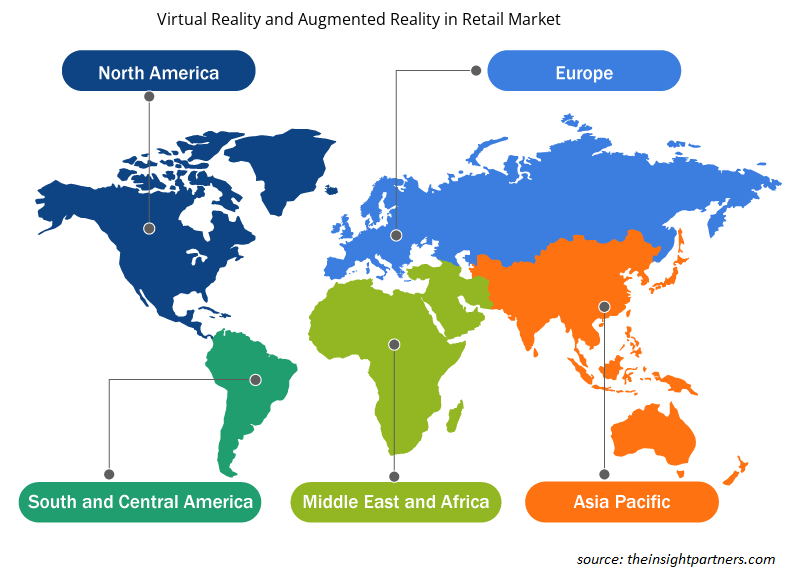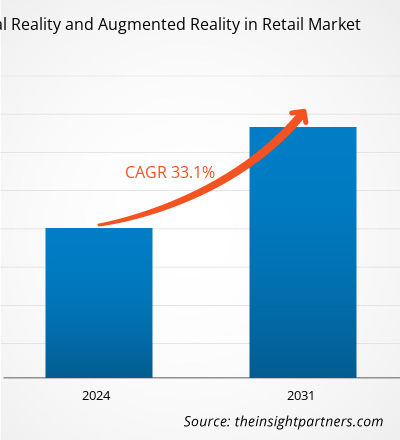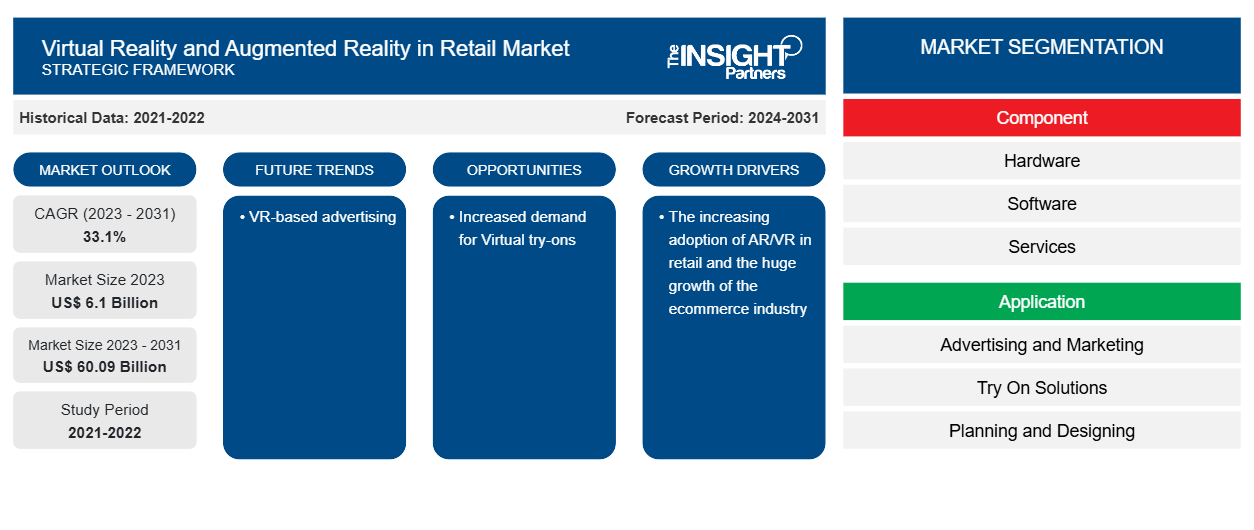소매 시장에서 가상 현실과 증강 현실은 2023년 61억 달러에서 2031년까지 600억 9천만 달러에 도달할 것으로 예상됩니다. 소매 시장에서 가상 현실과 증강 현실은 2023~2031년 동안 33.1%의 CAGR을 기록할 것으로 예상됩니다. VR 기반 광고는 시장에서 핵심 트렌드로 남을 가능성이 높습니다.
소매 시장 분석에서의 가상 현실과 증강 현실
소매업에서의 가상 현실과 증강 현실은 현재 시장 동향과 예측 기간 동안의 예측 가능한 영향으로 인해 성장 가능성이 있습니다. 소매업에서의 가상 현실과 증강 현실은 소매업에서 AR/VR의 채택 증가와 전자상거래 산업의 엄청난 성장과 같은 요인으로 인해 성장하고 있습니다. 소매업에서 가상 현실과 증강 현실에 대한 수익성 있는 기회를 제공하기 위한 가상 시도에 대한 수요 증가.
소매 시장에서의 가상 현실과 증강 현실 개요
가상 현실(VR)과 증강 현실(AR)은 몰입적이고 상호 작용적인 쇼핑 경험을 제공함으로써 소매업의 판도를 변화시키고 있습니다. VR은 고객이 가상 매장을 탐험하고, 제품을 3D로 시각화하고, 심지어 가상으로 옷을 입어볼 수 있는 완전히 디지털화된 환경을 만듭니다. 반면 AR은 디지털 정보를 현실 세계에 오버레이하여 쇼핑객이 스마트폰 앱이나 스마트 미러를 사용하여 가구가 집에서 어떻게 보일지 또는 얼굴에 화장이 어떻게 보일지 볼 수 있도록 합니다. 이 두 가지 기술 모두 소매업체가 온라인과 매장 쇼핑 간의 격차를 메우고, 제품 시각화를 향상시키고, 반품을 줄이고, 고객 참여와 판매를 촉진할 수 있는 매력적인 브랜드 경험을 만들 수 있도록 합니다.
귀하의 요구 사항에 맞게 이 보고서를 사용자 정의하세요
이 보고서의 일부 또는 국가 수준 분석, Excel 데이터 팩을 포함하여 모든 보고서에 대한 사용자 정의를 무료로 받을 수 있으며 신생 기업 및 대학을 위한 훌륭한 혜택과 할인 혜택을 이용할 수 있습니다.
-
이 보고서의 주요 시장 동향을 알아보세요.이 무료 샘플에는 시장 동향부터 추정 및 예측까지 다양한 데이터 분석이 포함됩니다.
소매 시장의 가상 현실과 증강 현실 동인 및 기회
소매업에서 AR/VR 채택 증가로 시장 선호
디지털 시대가 영향을 미친 주요 분야 중 하나는 소매 분야입니다. 월마트, 알리바바, 아마존을 포함한 대형 소매업체는 고객에게 보다 개인화되고 상호 작용적인 서비스를 제공하기 위해 최첨단 소매 기술에 적극적으로 투자합니다. 스마트 소매의 세 가지 기본 구성 요소는 편의성 향상, 개인화 및 사용자 정의입니다. AR 및 VR로 구동되는 애플리케이션과 같은 혁신적인 솔루션이 인기를 얻고 있습니다. 많은 소매업체가 Wayfair, Lowe's, Ikea와 같은 소매 거대 기업 이후 AR/VR 기술을 채택하기 시작했습니다. 예를 들어, 10억 명 이상의 사람들이 증강 현실 제품을 사용할 것으로 예상됩니다. 그 수는 엄청납니다. 가상 및 증강 현실을 통해 고객은 구매하기 전에 물건을 식별하고 시도하는 것이 더 쉬워집니다. 증강 현실을 사용하면 거대한 쇼핑몰 탐색이 더 쉬워질 것입니다.
가상 체험에 대한 수요 증가
가상 체험에 대한 수요 증가는 소매 시장 성장에서 VR 및 AR에 대한 상당한 기회를 제공합니다. 가상 체험은 고객이 구매하기 전에 제품을 보다 정확하게 시각화할 수 있도록 하여 반품률을 크게 줄일 수 있습니다. 이를 통해 소매업체는 배송 및 재입고 비용을 절감하여 수익성을 개선할 수 있습니다. 게다가 고객이 가상 체험을 통해 온라인 구매에 대한 확신을 갖게 되면 실제로 제품을 보지 않고도 구매할 가능성이 높아집니다. 이는 특히 의류 및 화장품 과 같은 범주에서 전자 상거래 판매를 촉진할 수 있습니다 . 가상 체험은 고객 참여와 만족도를 높일 수 있는 새롭고 상호 작용적인 쇼핑 경험을 제공합니다. 이는 브랜드 충성도와 반복 구매로 이어질 수 있습니다.
소매 시장 보고서 세분화 분석의 가상 현실 및 증강 현실
소매 시장 분석에서 가상 현실 및 증강 현실의 도출에 기여한 주요 세그먼트는 구성 요소, 애플리케이션 및 소매 유형입니다.
- 구성 요소에 따라 소매 시장에서 가상 현실과 증강 현실은 하드웨어, 소프트웨어, 서비스로 구분됩니다. 하드웨어 세그먼트는 2023년에 상당한 시장 점유율을 차지할 것입니다.
- 응용 프로그램별로 시장은 광고 및 마케팅, 시도 솔루션, 계획 및 디자인, 기타로 세분화됩니다. 광고 및 마케팅 부문은 2023년에 가장 큰 시장 점유율을 차지했습니다.
- 소매 유형 측면에서 시장은 보석, 의류, 뷰티 & 화장품, 가구, 기타로 세분화됩니다. 의류 부문은 2023년에 가장 큰 시장 점유율을 차지했습니다.
지역별 소매 시장 점유율 분석의 가상 현실 및 증강 현실
소매 시장 보고서의 가상 현실 및 증강 현실의 지리적 범위는 주로 북미, 아시아 태평양, 유럽, 중동 및 아프리카, 남미 및 중부 아메리카의 5개 지역으로 나뉩니다.
아시아 태평양 지역의 소매업에서 증강 현실(AR)과 가상 현실(VR)을 사용하는 것이 인기를 얻고 있습니다. 이러한 기술은 소매 경험을 향상시키고 고객 참여를 촉진하기 위해 다양한 방식으로 점점 더 많이 활용되고 있습니다. 이러한 기술은 소매 경험을 향상시키고, 고객 참여를 촉진하고, 업계에서 마케팅, 교육 및 훈련에 대한 새로운 기회를 제공할 잠재력이 있습니다.
소매 시장의 가상 현실과 증강 현실 지역 통찰력
Insight Partners의 분석가들은 예측 기간 동안 소매 시장에서 가상 현실과 증강 현실에 영향을 미치는 지역적 추세와 요인을 철저히 설명했습니다. 이 섹션에서는 북미, 유럽, 아시아 태평양, 중동 및 아프리카, 남미 및 중미의 소매 시장에서 가상 현실과 증강 현실 세그먼트와 지역에 대해서도 설명합니다.

- 소매 시장에서 가상 현실 및 증강 현실에 대한 지역별 특정 데이터 얻기
소매 시장 보고서 범위의 가상 현실 및 증강 현실
| 보고서 속성 | 세부 |
|---|---|
| 2023년 시장 규모 | 61억 달러 |
| 2031년까지 시장 규모 | 600억 9천만 달러 |
| 글로벌 CAGR (2023-2031) | 33.1% |
| 역사적 데이터 | 2021-2022 |
| 예측 기간 | 2024-2031 |
| 다루는 세그먼트 |
구성 요소별로
|
| 포함된 지역 및 국가 |
북아메리카
|
| 시장 선도 기업 및 주요 회사 프로필 |
|
소매 시장 플레이어 밀도에서의 가상 현실 및 증강 현실: 비즈니스 역학에 미치는 영향 이해
소매 시장에서의 가상 현실과 증강 현실 시장은 소비자 선호도의 변화, 기술 발전, 제품의 이점에 대한 인식 증가와 같은 요인으로 인해 최종 사용자 수요가 증가함에 따라 빠르게 성장하고 있습니다. 수요가 증가함에 따라 기업은 제품을 확장하고, 소비자의 요구를 충족하기 위해 혁신하고, 새로운 트렌드를 활용하여 시장 성장을 더욱 촉진하고 있습니다.
시장 참여자 밀도는 특정 시장이나 산업 내에서 운영되는 회사나 기업의 분포를 말합니다. 주어진 시장 공간에 얼마나 많은 경쟁자(시장 참여자)가 존재하는지 그 규모나 총 시장 가치에 비해 나타냅니다.
소매 시장에서 가상 현실 및 증강 현실 분야에서 운영되는 주요 회사는 다음과 같습니다.
- 에프슨 아메리카 주식회사
- 마르크센트
- 구글 유한회사
- 인포시스 유한회사
- 인텔 코퍼레이션
- 마이크로소프트 주식회사
면책 조항 : 위에 나열된 회사는 어떤 특별한 순서에 따라 순위가 매겨지지 않았습니다.

- 소매 시장에서 가상 현실과 증강 현실의 주요 업체 개요를 알아보세요
소매 시장에서의 가상 현실과 증강 현실 뉴스 및 최근 개발
소매 시장에서의 가상 현실과 증강 현실은 1차 및 2차 연구 이후의 질적, 양적 데이터를 수집하여 평가합니다. 여기에는 중요한 기업 간행물, 협회 데이터 및 데이터베이스가 포함됩니다. 소매 시장에서의 가상 현실과 증강 현실의 몇 가지 개발 사항은 다음과 같습니다.
- Apple은 600개의 새로운 앱과 게임이 포함된 최초의 혼합 현실 헤드셋인 Vision Pro를 출시했습니다. 여기에는 주요 리테일러의 증강 현실(AR) 및 가상 현실(VR) 진출이 포함되어 소비자에게 더욱 상호 작용적인 전자 상거래 여정을 제공할 수 있는 역량을 활용했습니다. Vision Pro 앱은 헤드셋 사용자에게 3D 쇼핑 경험을 제공하여 제품을 살펴보고 옷을 조립할 수 있도록 합니다. 또한, FaceTime 화상 통화를 위한 Apple SharePlay 기능을 통합하여 리테일러는 이 실제와 같은 환경에서 스타일리스트의 실시간 조언을 제공할 수 있습니다. (출처: Apple, 보도 자료, 2024년 2월)
- Zero10은 Tommy Hilfiger와 Coach와 같은 브랜드에 매장과 윈도 디스플레이를 활용한 AR 미러를 통해 디지털 솔루션을 제공합니다. Tommy Hilfiger는 또한 유럽에서 기술 회사 Zero10의 AR 미러를 Shawn Mendes 캠페인의 일부로 사용하고 최근 퍼퍼 재킷 출시를 홍보합니다. 한편 Coach는 Zero10의 AR 미러와 AR 매장을 사용하여 Tabby 백과 홀리데이 시즌 캠페인을 홍보합니다(출처: Zero10, 보도 자료, 2024년 4월)
소매 시장 보고서의 가상 현실 및 증강 현실 범위 및 제공물
"소매 시장 규모 및 예측(2021-2031)의 가상 현실 및 증강 현실" 보고서는 아래 영역을 포괄하는 시장에 대한 자세한 분석을 제공합니다.
- 범위에 포함된 모든 주요 시장 세그먼트에 대한 글로벌, 지역 및 국가 수준의 소매 시장 규모 및 예측에서의 가상 현실 및 증강 현실
- 소매 시장 동향에서의 가상 현실 및 증강 현실, 그리고 동인, 제약 및 주요 기회와 같은 시장 역학
- 자세한 PEST/포터의 5가지 힘과 SWOT 분석
- 소매 시장 분석에서 가상 현실 및 증강 현실은 주요 시장 동향, 글로벌 및 지역 프레임워크, 주요 업체, 규정 및 최근 시장 개발 사항을 포괄합니다.
- 소매 시장에서 가상 현실 및 증강 현실에 대한 시장 집중도, 히트맵 분석, 유명 업체 및 최근 개발 사항을 포함하는 산업 환경 및 경쟁 분석
- 자세한 회사 프로필
- 과거 분석(2년), 기준 연도, CAGR을 포함한 예측(7년)
- PEST 및 SWOT 분석
- 시장 규모 가치/거래량 - 글로벌, 지역, 국가
- 산업 및 경쟁 환경
- Excel 데이터세트
최근 보고서
사용 후기
구매 이유
- 정보에 기반한 의사 결정
- 시장 역학 이해
- 경쟁 분석
- 고객 인사이트
- 시장 예측
- 위험 완화
- 전략 기획
- 투자 타당성 분석
- 신흥 시장 파악
- 마케팅 전략 강화
- 운영 효율성 향상
- 규제 동향에 발맞춰 대응























 무료 샘플 받기 - 소매 시장에서의 가상 현실과 증강 현실
무료 샘플 받기 - 소매 시장에서의 가상 현실과 증강 현실